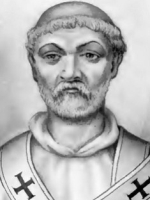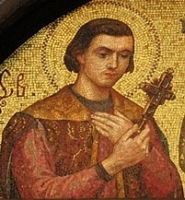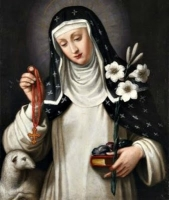Bl. Maria Gabriella Sagheddu
Feastday: April 22
Patron: of Ecumenism
Birth: 1914
Death: 1939
Beatified: 25 January 1983, Basilica of St. Paul outside the Walls, Rome, Italy by John Paul II
Blessed Sister Maria Gabriella Sagheddu was a Trappist nun. She was born in Sardinia in 1914 and died of tuberculosis in the Trappist monastery of Grottaferrata in 1939. Because of her spiritual devotion to Christian unity, she was beatified by pope John Paul II in 1983.
Maria Sagheddu (17 March 1914 – 23 April 1939) - in religious Maria Gabriella - was an Italian Catholic professed religious and a professed member from the Trappists.[1] Sagheddu had an intense spiritual devotion to ecumenism - something for which she had offered her life - since she desired that all would become one in Jesus Christ. Her childhood saw her noted as stubborn and obstinate though her increased activeness in teaching catechism and joining Azione Cattolica saw those qualities melt and become gentleness and careful attentiveness.
Sagheddu was beatified in Rome in 1983.
Life
Maria Sagheddu was born to shepherds in Dorgali on 17 March 1914 as the fifth of eight children to Marcantonio Sagheddu and Caterina Cucca. Her father and one brother died in 1919 as did two other brothers sometime in their childhood.[1] Sagheddu was said to be obstinate as a child but was also known to be obedient; she was also described as being prone to laziness on occasion.[2] Once she concluded her initial education as a child she had to leave school to help out at home where she showed herself serious and endowed with a great sense of care and dutiful obedience. Yet she was often quick to criticize what she disliked and quick to ask for what she wanted.[3] There was one occasion when her mother asked her to throw out some potato peels though she ignored this despite her mother's firm insistence that she do so. Sagheddu relented and did this but returned a moment later with the peels in hand in which she decided she did not want to throw them. Sagheddu was ranked among the best at her school where she was alert and intelligent; she excelled in arithmetic most of all her other subjects.
The death of her little sister Giovanna Antonia (whom she was closest to and was born in 1915) in 1932 prompted her to deepen her faith and she decided to enroll in Azione Cattolica not long after this.[2] It was there that she began to instruct the local children and adolescents in the faith and also to help the aged of the region.[1] In the process she began to augment her spiritual and contemplative life; she at first taught catechism with a stick in hand. But the local priest took the stick from her on one occasion and replaced it with a note that said: "Arm yourself with patience, not a stick". Sagheddu accepted the criticism and changed her methods from that moment on.
Father Meloni helped her in entering the religious life for he was the single individual she had confided her dream in. Her mother approved this but reproached her for not having told her sooner. One brother even disapproved of her decision and believed that she would bring nothing more than disgrace upon their home.[3][2] On 30 September 1935 she entered the Trappists at their convent in Grottaferrata near Rome where she was given the religious name of Maria Gabriella; she was clothed in the habit for the first time on 13 April 1936 and made her vows on 31 October 1937 which marked the Feast of Christ the King.[3] The abbess of the convent at that time there was Mother Maria Pia Gullini whose enthusiasm for ecumenism (a fruit of the efforts of Abbé Paul Couturier) was passed on to the others there. Sagheddu became an ardent devotee to this cause and she offered herself as a spiritual sacrifice for the unification of the Christian Church during the special week for Christian unification in 1938.
Sagheddu fell ill with tuberculosis after a diagnosis in Rome and suffered with the disease for fifteen months before she died during the evening on 23 April 1939. The doctors declared her condition incurable in May 1938.[2] The significant fact here is that the Gospel reading for that week included the words: "There will be one flock and one shepherd" (John 10:16). Sagheddu's remains are kept in a chapel at a Trappistine convent at Vitorchiano near Viterbo and were found to be incorrupt in 1957 upon exhumation.
Pope Saint Soter
புனிதர் சொத்தேர்
12ம் திருத்தந்தை:
இயற்பெயர்: சொத்தேர் (Soter)
பிறப்பு: ----
ஃபோண்டி, காம்பானியா, ரோம பேரரசு
இறப்பு: கி.பி 174
ரோம், ரோம பேரரசு
ஏற்கும் சமயம்:
ரோமன் கத்தோலிக்க திருச்சபை
நினைவுத் திருநாள்: ஏப்ரல் 22
திருத்தந்தை புனித சொத்தேர் (Pope Soter), கி.பி. இரண்டாம் நூற்றாண்டின் பிற்பகுதியில் உரோமை ஆயராகவும், திருத்தந்தையாகவும் ஆட்சிப்பொறுப்பில் இருந்தார். வரலாற்றில் இவர் 12ம் திருத்தந்தை ஆவார். இவரது ஆட்சிக்காலம் கி.பி. 162-168 அளவில் தொடங்கியது என்றும், கி.பி. 170-177 அளவில் நிறைவுற்றது என்றும் வத்திக்கானிலிருந்து (Vatican) வெளியாகும் "திருத்தந்தை ஆண்டுக் குறிப்பேடு" (Annuario Pontificio) என்னும் நூல் கூறுகிறது.
பிறப்பும் பெயரும்:
இவரது பெயர் மீட்பர், விடுதலை அளிப்பவர் எனப் பொருள்படும் கிரேக்க சொல்லிலிருந்து வந்தாலும், இவர் கிரேக்கர் அல்லர். ஒருவேளை இவர் கிரேக்க பின்னணியிலிருந்து வந்திருக்கலாம். இவர் இத்தாலி (Italy) நாட்டில் கம்பானியா (Campania) பகுதியில் ஃபோந்தி (Fondi) என்னும் நகரில் பிறந்தார்.
"இரக்கம் மிகுந்த திருத்தந்தை":
வரலாற்றில் சொத்தேர் "இரக்கம் மிகுந்த திருத்தந்தை" (Pope of Charity) என்று அறியப்படுகிறார். திருத்தந்தையாகப் பொறுப்பேற்ற சிறிது காலத்திலேயே, சொத்தேர் உரோமைத் திருச்சபையிலிருந்து காணிக்கை பிரித்து அதை கிரேக்க நாட்டில் கொரிந்து (Dionysius of Corinth) திருச்சபைக்கு அனுப்பிவைத்தார். தேவையில் உழன்ற கொரிந்து திருச்சபைக்கு உதவி செய்த சொத்தேர் எழுதிய மடல் கிடைக்கப்பெறவில்லை. ஆனால் தாம் பெற்ற உதவிக்கு நன்றிகூறி கொரிந்து நகர் ஆயர் தியோனேசியுசு சொத்தேருக்கு எழுதிய நன்றி மடல் இன்றும் உள்ளது.
சீர்திருத்தங்கள்:
இவரே திருமணம் குருவால் ஆசிர்வதிக்கப்பட்டால் தான் முறையான திருவருட்சாதனம் ஆகும் என ஒழுங்கு அமைத்தார்.
இயேசுவின் உயிர்த்தெழுதல் விழா ஒவ்வொரு ஆண்டும் உரோமையில் கொண்டாடப்பட வேண்டும் என்று சொத்தேர் அதிகாரப்பூர்வமாக அறிவித்தார்.
இறப்பும் அடக்கமும்:
இவரது விழாநாளும், கி.பி. 296ம் ஆண்டு இறந்த திருத்தந்தை காயுஸின் விழா நாளும் ஏப்ரல் 22 ஆகும். புனிதர்களின் பெயர்ப் பட்டியலை அதிகாரப்பூர்வமாக வழங்குகின்ற "உரோமை மறைச்சாட்சியர் நூல்" (Roman Martyrology) என்னும் ஏடு சொத்தேர் பற்றிக் கீழ்வருமாறு குறிப்பிடுகிறது:
"உரோமையில் திருத்தந்தை புனித சொத்தேரின் விழா கொண்டாடப்படுகிறது. இவர் தம்மை நாடிவந்த நாடுகடத்தப்பட்ட ஏழைக் கிறிஸ்தவர்களுக்குத் தாராளமாக உதவிசெய்தார். சுரங்கங்களில் வேலை செய்ய அனுப்பப்பட்டவர்களுக்கு இரக்கம் காட்டினார் என்று கொரிந்து நகர் தியோனீசியுசு புகழ்ந்துள்ளார்".
தொடக்க கால திருத்தந்தையர் அனைவரும் மறைச்சாட்சிகளாக இரத்தம் சிந்தி இறந்தார்கள் என மரபுச் செய்தி இருந்தாலும், "உரோமை மறைச்சாட்சியர் நூல்" (The Roman Martyrology), சொத்தேருக்கு மறைச்சாட்சி (Martyr) என்னும் அடைமொழி கொடுக்கவில்லை.
திருத்தந்தையர் சொத்தேரும், காயுசும் (Pope Caius) மறைச்சாட்சிகளாக இரத்தம் சிந்தி இறந்தார்கள் என்பதற்கு அடிப்படை இல்லை என்று "கத்தோலிக்க திருச்சபையின் பொது நாள்காட்டி" (General Roman Calendar) (1969 திருத்தம்) கூறுகின்றது.
கல்லறை
சொத்தேர் இறந்ததும் புனித கலிஸ்து கல்லறைத் தோட்டத்தில் அடக்கம் செய்யப்பட்டார். மற்றொரு மரபுப்படி, அவர் புனித பேதுருவின் கல்லறை அருகே அடக்கம் செய்யப்பட்டார். பின்னர், திருத்தந்தை இரண்டாம் செர்ஜியுஸ் காலத்தில் சொத்தேரின் உடல் புனிதர்கள் சில்வெஸ்தர் மற்றும் மார்ட்டின் என்பவர்களின் கோவிலில் புதைக்கப்பட்டது.
இன்னொரு மரபுப்படி, அவரது உடலின் ஒரு பகுதி எசுப்பானியா நாட்டில் தொலேதோ நகர் பெருங்கோவிலில் பாதுகாக்கப்படுகிறது.
Also known as
• Pope of Charity
• Sotero
• Soterius
• Soterus
Profile
Nothing is known of his life before he was chosen 12th pope c.166, and not much is known of his pontificate. Forbade women to burn incense in services. Ratified that matrimony was a valid sacrament only if blessed by a priest. Inaugurated Easter as an annual festival in Rome.
Born
at Fondi, Italy
Papal Ascension
c.166
Died
• tradition says he was martyred c.175, though no evidence has survived
• buried in the Callistus cemetery in Rome, Italy
Pope Saint Caius I
Also known as
• Caius the Dalmatian
• Cayo, Gaius
Additional Memorial
11 August (Eastern calendar)
Profile
Some unreliable early documents indicate he was from Spalato in Dalmatia, may have been a relative of Emperor Diocletian, and the uncle of Saint Susanna. However, nothing reliable is known of his early life.
Pope in a time of peace before the last great persecution of Rome, and little concerning his papacy has survived. Decreed that before a man could be bishop, he must first be porter, reader, exorcist, acolyte, sub-deacon, deacon, and priest. Divided the districts of Rome among deacons.
Originally listed as a martyr based on the tales of his suffering during the Diocletian persecutions, these did not begin until years after his death, and there is no evidence of his suffering or martyrdom. This lack of verifiable information led to his name being dropped from the Martyrology.
Papal Ascension
17 December 283
Died
• 22 April 296 of natural causes
• buried in the chamber next to the papal crypt in the Catacombs of Saint Callistus on the Appian Way
Saint Opportuna of Montreuil
புனித_ஆப்பர்சூனா (-770)
ஏப்ரல் 22
இவர் (#StOppertunaOfMontreuil) பிரான்ஸ் நாட்டைச் சார்ந்தவர். இவருக்கு குரோத்கேங் (Chrodegang) என்றொரு சகோதரர் இருந்தார். அவர் நார்மண்டியில் ஆயராக இருந்தார். ஒருமுறை அவர் உரோமைக்குச் சென்று, திரும்பி வரும் வழியில் கொல்லப்பட்டார்.
ஆப்பர்சூனா வளரும் போதே இறைவன்மீது ஆழமான நம்பிக்கை கொண்டவராய் வளர்ந்தார். இவர் பெரியவரான போது, பெனடிக்ட் துறவு அவையில் சேர்ந்து துறவியானார்.
தாழ்ச்சிக்கும் கீழ்ப்படிதலுக்கும் ஒறுத்தல் முயற்சிகளுக்கும் மிகப் பெரிய எடுத்துக்காட்டாக விளங்கிய இவர் படிப்படியாக உயர்ந்து, துறவு மடத்தின் தலைவியானார்.
ஒரு சமயம் இவருடைய மடத்தில் இருந்த ஒரு கழுதையை விவசாயி ஒருவர் திருடிவிட்டார். இது குறித்து இவர் விவசாயியிடம் கேட்டபொழுது அவர் மறுத்துவிட்டார். இதை முன்னிட்டு இவர் இறைவனிடம் வேண்டிய பொழுது, விவசாயியின் நிலத்தில் உப்பு மலை பெய்தது. இதைக் கண்டு மிரண்டு போன விவசாயி, தான் திருடிய கழுதையைக் கொண்டு வந்து, இவரிடம் ஒப்படைத்து, செய்த தவறுக்காக மன்னிப்புக் கேட்டார்.
இவ்வாறு அற்புதங்கள் பல செய்த இவர் 770 ஆம் ஆண்டு இறையடி சேர்ந்தார்.
Also known as
Opportune
Profile
Sister of Saint Chrodegang of Séez. Niece of Saint Lanthilda. Benedictine nun and abbess at the convent near Almenêches, France, receiving the veil from her brother. Legend says that a peasant stole a donkey from her convent and refused to acknowledge his crime. Opportuna turned it over to God; the next day the farmer's field was sown with salt. The peasant returned the donkey AND gave the field to the nuns.
Born
at castle of Exmes, Argentan, Normandy, France
Died
• 22 April 770 from a brief illness compounded by grief from the death of her brother
• relics taken to the priory of Moussy, France, in 1009, and then to Senlis, France
• in 1374 her right arm and a rib were taken to Paris, France to a church built in her honor
• part of her head remains at Moussy
• her left arm and part of her skull are at Almenêches
• one jaw is in the priory of Saint Chrodegang of Metz at Isle-Adam
Blessed Francis of Fabriano
Also known as
Francis Venimbeni
Profile
Born to a wealthy family, the son of Compagno Venimbeni, a physician, and Margaret di Federico. Studied humanities and philosophy, then joined the Franciscans in 1267, at age 16; he spent part of his novitiate studying under the companions of Saint Francis of Assisi. Friar. Priest who offered his Masses for souls in Purgatory. Missionary in the region of his house. A man of endless prayer and work, he insisted that this brother friars stay strictly orthodox in their preaching and teaching, and to insure they had the proper background, used his family money to purchase an extensive library for them. Wrote on matters of theology and philosophy, but only time scraps of his work have survived.
Born
2 September 1251 in Fabriano, Ancona, Italy
Died
22 April 1322 of natural causes
Beatified
1 April 1775 by Pope Pius VI (cultus confirmation)
Saint Epipodius of Lyon
Profile
Friend of and worker with Saint Alexander of Lyon. Imprisoned, tortured, and martyred during the persecutions of Marcus Aurelius. Though he never joined an order, Epipodius was a confirmed celibate bachelor, devoting his time to work with and for God. Betrayed to imperial authorities by a servant. Martyr.
Born
2nd century at Lyon, France
Died
• beheaded in 178
• relics at the church of Saint Irenaeus at Lyon, France
• miracles reported at the tomb
Patronage
• bachelors
• betrayal victims
• torture victims
Pope Saint Agapitus I
Also known as
Agapetus I
Additional Memorial
20 September (date of internment in Saint Peter's Basilica)
Profile
Son of a priest named Gordian; his father was murdered. Archdeacon of the priests of Rome, Italy. Elected pope when a very old man, he reigned for less than a year. Died while on a mission to prevent the invasion of Italy by Justinian. He failed in that, but succeeded in having the Monophysite Patriarch of Constantinople, Anthimus, replaced by the more orthodox Mennas.
Born
in Rome, Italy
Papal Ascension
13 May 535
Died
• 22 April 536 in Constantinople of natural causes
• interred in Saint Peter's Basilica, Rome, Italy
Saint Altfried of Münster
Also known as
Altfrid, Altfrith
Profile
Monk. Priest. Fifth abbot of the monastery of Werden, Germany. Abbot of the monastery of Helmstedt, Germany. Nephew of Saint Liudger, first bishop of Münster, Germany; related to Saint Gerfried of Münster, the second bishop; Altfried served as third bishop from 839 until his death ten years later. He wrote a biography of Saint Liudger.
Born
9th century, possibly in Friesland (in modern Netherlands)
Died
• 22 April 849 of natural causes
• buried in the Liudgerid crypt at the monastery of Werden, Germany
Blessed Stephen of Nagyvárad
Also known as
Stephen of Hungary
Profile
Franciscan friar. Imprisoned for his faith, he escaped and sought shelter in Sarai Batu (modern Selitrennoye, Russia). To save himself from his persecutors, he denied that he was Christian and announced his conversion to Islam. He immediately repented this apostasy, declared that he was a Christian, and was executed. Martyr.
Born
Naggyvarad, Transylvania (modern Oradea, Romania)
Died
• sentenced to burn at the stake, the fire was twice miraculously extinguished, so his killers stoned him and finally stabbed him with a sword on 22 April 1334 in Sarai Batu (modern Selitrennoye, Russia)
• the site of his death became known for miraculous healings
Saint Leonidas of Alexandria
Also known as
Leonides
Profile
Wealthy and pious layman. Father of seven sons, the eldest of whom was the philosopher Origen, whom he raised and taught. Philosopher and rhetorician. Imprisoned and martyred by command of Laertus, Governor of Egypt, during the persecutions of emperor Septimius Severus. All his property was confiscated, and his family reduced to complete poverty until they were "adopted" by a wealthy Christian woman.
Died
beheaded in 202 at Alexandria, Egypt
Patronage
large families
Saint Theodore of Sykeon
Also known as
• Theodore of Siceone
• Theodore of Sikion
• Theodore the Sykeote
Profile
Son of a pagan imperial messenger. Convert. Monk. Priest. Bishop of Anastasiopolis, Galatia. Founded monasteries. Had the gift of healing. Miracle worker. Warded off a plague of insects by prayer. Supported the cultus of Saint George.
Born
at Sykeon, Galatia
Died
c.613
Patronage
• against rain
• difficult marriages
• for rain
Saint Senorina
Profile
Related to Saint Rudesind of Mondoñedo. Raised by her aunt, Abbess Godina at the convent of Saint John of Venaria, Italy. Senorina joined the convent as a nun and eventually became its abbess. She later moved the convent and sisters to Basto, Portugal.
Died
982
Blessed Adalberto of Ostrevant
Profile
Born to the wealthy 8th century nobility, he was the Count of Ostrevant, and served in the Frankish royal court. Married and the father of ten daughters, including Blessed Ragenfreda. Adalberto was known for his piety and charity, and help found the convent in Denain, Hainault where his daughter was abbess.
Died
22 April c.790
Saint Euflamia
Profile
Soldier. Imperial Roman legionaire. Martyr.
Died
• buried in the cemetery of Saint Priscilla in Rome, Italy
• re-interred under the main altar of Saint Peter's Basilica
• relics transferred to Cherasco, Italy in 1623 by Pope Gregory XV
Patronage
Cherasco, Italy
Saint Virginio
Profile
Soldier. Imperial Roman legionaire. Martyr.
Died
• buried in the cemetery of Saint Priscilla in Rome, Italy
• re-interred under the main altar of Saint Peter's Basilica
• relics transferred to Cherasco, Italy in 1623 by Pope Gregory XV
Patronage
Cherasco, Italy
Saint Aceptismas of Hnaita
Also known as
Acepsimas
Profile
Bishop of Hnaita, Persia. Over 80 years old, he was tortured and martyred in the persecutions of King Sapor II.
Died
beaten to death on 10 October 376 in Persia
Saint Lucius of Laodicea
Profile
First-century convert, and may have been on of the 72 chosen by Jesus as missionaries. Bishop of Laodicea. Mentioned by Saint Paul the Apostle in his Epistle to the Romans. Martyr.
Saint Apelles of Smyrna
Also known as
Apellius of Smyrna
Profile
First century convert. Bishop of Smyrna. Saint Paul greeted him as "approved in Christ" in Romans 16. Martyr.
Saint Joseph of Persia
Profile
Priest. Martyred with Saint Acepsimas in the persecution of King Shapur II.
Died
376 in Persia
Saint Arwald
Profile
Son of a prince on the Isle of Wight. Martyred by the then-pagan King Caedwalla on the day after his baptism.
Died
686
Saint Helimenas
Profile
Priest. Martyred when Decius invaded Mesapotamia.
<
Died
beheaded c.250 at Babylon
Saint Maryáhb
Profile
Priest. Martyred in the persecutions of Shapur II.
Died
341 in Persia
Saint Leo of Sens
Profile
Bishop of Sens, France for 22 years.
Died
541
Saint Abel McAedh
Profile
Holy Irish woman.
Born
Irish
Martyrs of Persia
Profile
Bishops, priests, deacons and laity who were martyred in Persia and celebrated together. Several of them have their stories related in the Acta of Saints Abdon and Sennen.
• Abdiesus the Deacon
• Abrosimus
• Aceptismas of Hnaita
• Aithilahas
• Azadanes the Deacon
• Azades the Eunuch
• Bicor
• Chrysotelus
• Helimenas
• James
• Joseph
• Lucas
• Mareas
• Milles
• Mucius
• Parmenius
• Tarbula
Also celebrated but no entry yet
• Martyrs of Alexandria






























